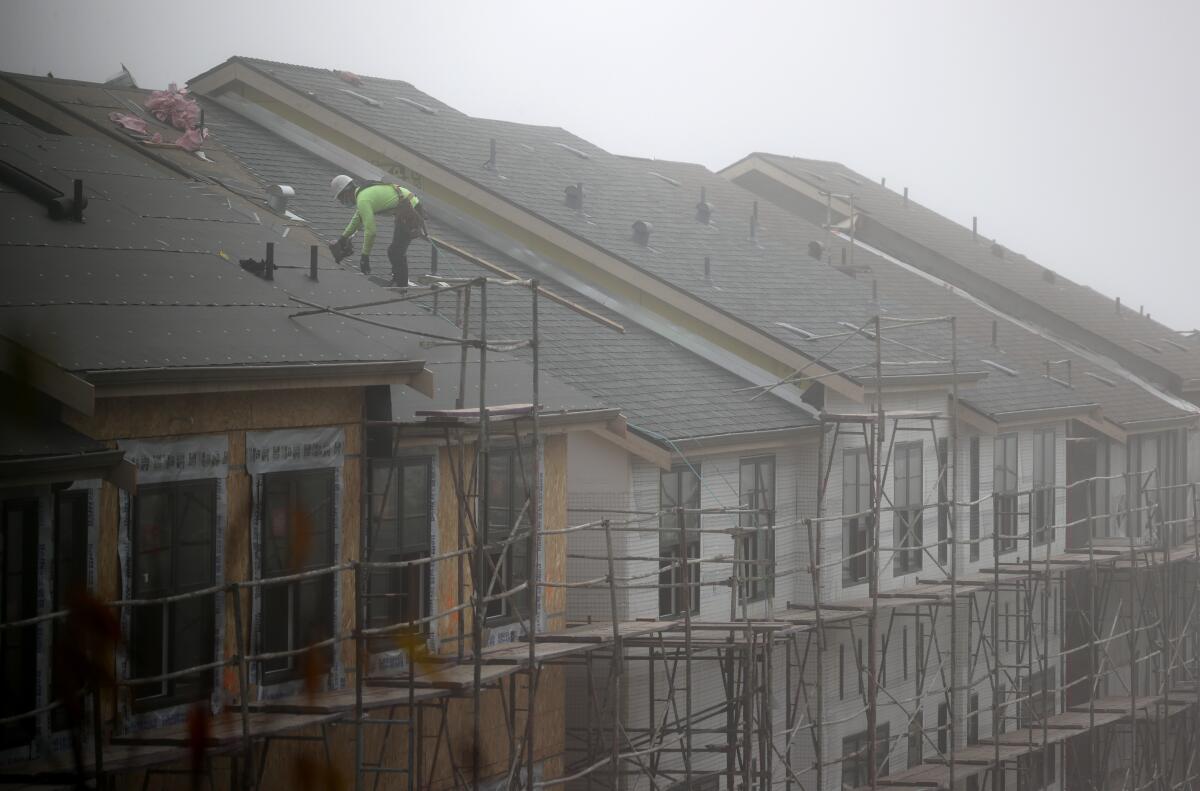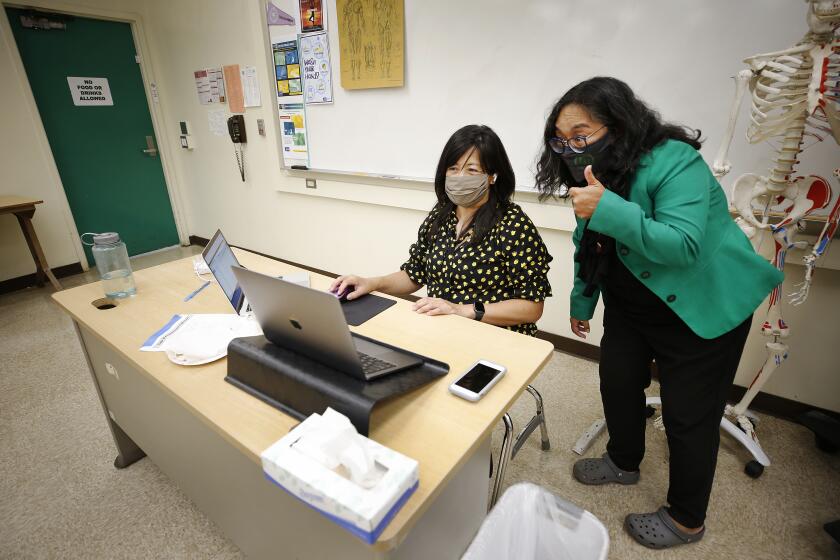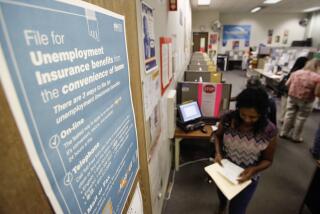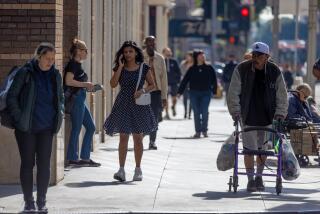Think California is bouncing back? Recovery will take more than two years, economists say

- Share via
California’s economy began to bounce back this summer thanks to an infusion of federal jobless benefits and business loans along with the reopening of some workplaces, but a full recovery from the coronavirus downturn will take more than two years, UCLA economists predict.
The UCLA Anderson quarterly forecast released Wednesday suggested California payrolls will drop 7.2% this year to 16 million jobs, a loss of some 1.5 million since the COVID-19 pandemic hit. They are expected to climb back slowly, by just 1.3% next year and 3.5% in 2022.
The Golden State’s unemployment rate, which was 3.9% in February, will average 10.8% this year, then fall to 8.6% next year and 6.6% in 2022, the forecast calculated.
Nonetheless, “the news is not all bad,” economist Leila Bengali wrote in the report, noting that some industries are faring far better than others. A precipitous drop in travelers has hammered California’s leisure and hospitality sector, where payrolls are projected to fall 25% this year, but “the housing market is an area where we project particular strength and a quick recovery to pre-recession levels.”
Residential building permits slowed at the start of the pandemic but will be back to a normal pace by year’s end, the forecast predicted, and will climb to 127,000 units in 2022 from an estimated 105,000 this year.
The California economy will “largely track movements in the U.S. economy with some areas displaying more weakness and some displaying more strength,” Bengali wrote. For example, professional and business services, which includes many technology jobs, may be stronger in California, while leisure and hospitality, along with such industries as auto repair and personal care, will be weaker.
Still, those predictions could be too rosy given COVID-19’s fluctuating path and the uncertainty of vaccines and treatments that could affect how many businesses are able to revive.
“Our forecast assumes either widespread availability and usage of an effective vaccine in early 2021 or that the pandemic’s impact on economic activity abates and is relatively mild in 2021 and 2022,” economists Leo Feler and Jerry Nickelsburg wrote in the U.S. section of the report, titled “The Recovery Is Losing Momentum.”
Moreover, the UCLA forecast assumed that Congress will allocate at least $1 trillion in fiscal stimulus before the end of the year — even though negotiations for new federal relief have been at a standstill for months with little sign of progress.
“None of these assumptions are assured, and if they do not come to pass, our forecast, presented here, is too optimistic,” Feler and Nickelsburg caution.
California gained 101,900 jobs in August, mostly due to the temporary hiring of federal census takers.
The $600 weekly supplement to state benefits that the federal CARES Act extended to the jobless expired at the end of July, and a $300 weekly supplement for some workers ended this month. A federal program giving jobless benefits to gig workers and the self-employed is set to expire at the end of the year.
Gig workers — including such diverse occupations as ride-hailing drivers, lawyers, technology contractors and entertainment industry artists and writers — are not eligible for state unemployment benefits, which are only funded for payroll employees. From 2005 to 2018, gig worker numbers skyrocketed by 30% to more than 26 million in the U.S. and by 39% in Los Angeles County to 1.1 million, according to a section in the forecast by economist William Yu.
Congress has also not renewed the Paycheck Protection Program, through which small businesses could get forgivable loans on the condition they maintained their workforces. From April through August, 623,000 California businesses that collectively provide an estimated 6 million jobs received loans under the federal program.
Overall, the U.S. economy reopened faster than expected in the third quarter of this year because many consumers and businesses adapted to remote working and the Federal Reserve committed to low interest rates, Feler and Nickelsburg wrote.
Nonetheless, they predict a 4.2% decline in the nation’s real gross domestic product this year — bigger than the 2.8% drop the U.S. experienced in 2008 during the Great Recession. They expect 3.5% growth in 2021 and 4% growth in 2022.
However, “even as the economy recovers, the sticking point is unemployment,” they wrote, forecasting the nation’s joblessness will drop from its 14.7% peak in April to 7.8% by the end of the year and gradually to 4.7% by the end of 2022. It won’t reach pre-pandemic rates before late 2024, they estimated.
Despite workers returning from temporary layoffs as some businesses reopen, “continued recovery will be much more arduous as more bankruptcies unfold and slack demand for sectors with high human contact continues,” Feler and Nickelsburg predicted.
Businesses fear they’ll be blamed for COVID-19’s spread. They’re fighting for measures to protect them from lawsuits over infections, hospitalizations and deaths.
They also noted slower recovery for Black people and for women than for white men. In August, 13.2% of Black men nationwide were unemployed, compared with 6.9% of white men; 12.5% of Black women were jobless versus 7.3% of white women.
Education-related gaps have widened considerably with the pandemic, they wrote. In August, 9.8% of workers with just a high school degree were jobless, compared with 5.3% of those with at least a bachelor’s degree.
The report noted a stock market recovery driven by “an economy that is led by a concentrated number of large, capital-intensive technology titans, one where many labor-intensive sectors that provide the goods and services for human interaction lag far behind.”
Leaders are companies that enable remote working (such as Zoom Video Communications Inc., Apple Inc. and Microsoft Corp.), shopping from home (Amazon.com Inc. and Wayfair Inc.), exercising at home (Peloton Interactive Inc.), shipping goods to homes (United Parcel Service Inc. and FedEx Corp.), meal delivery (Grubhub Inc.) or home improvement (Home Depot Inc.). Laggards include airlines, hotels, cruise lines, theme parks, movie theaters, restaurants and gyms.
UCLA’s forecast, a widely watched report now in its 69th year, is in line with that of other economists.
“Recovery from here will be much more difficult,” said Scott Anderson, chief economist at Bank of the West in San Francisco. “Growth is already slowing and downside risks are building as another round of federal aid is delayed. Some industries won’t fully recover until long after the pandemic has ended.”
His California forecast, published Sept. 22, predicted somewhat higher California job growth next year: 2%, as opposed to UCLA’s forecast of 1.3%. He also assumes at least $1 trillion in new federal aid and a vaccine by early next year.
More to Read
Inside the business of entertainment
The Wide Shot brings you news, analysis and insights on everything from streaming wars to production — and what it all means for the future.
You may occasionally receive promotional content from the Los Angeles Times.













